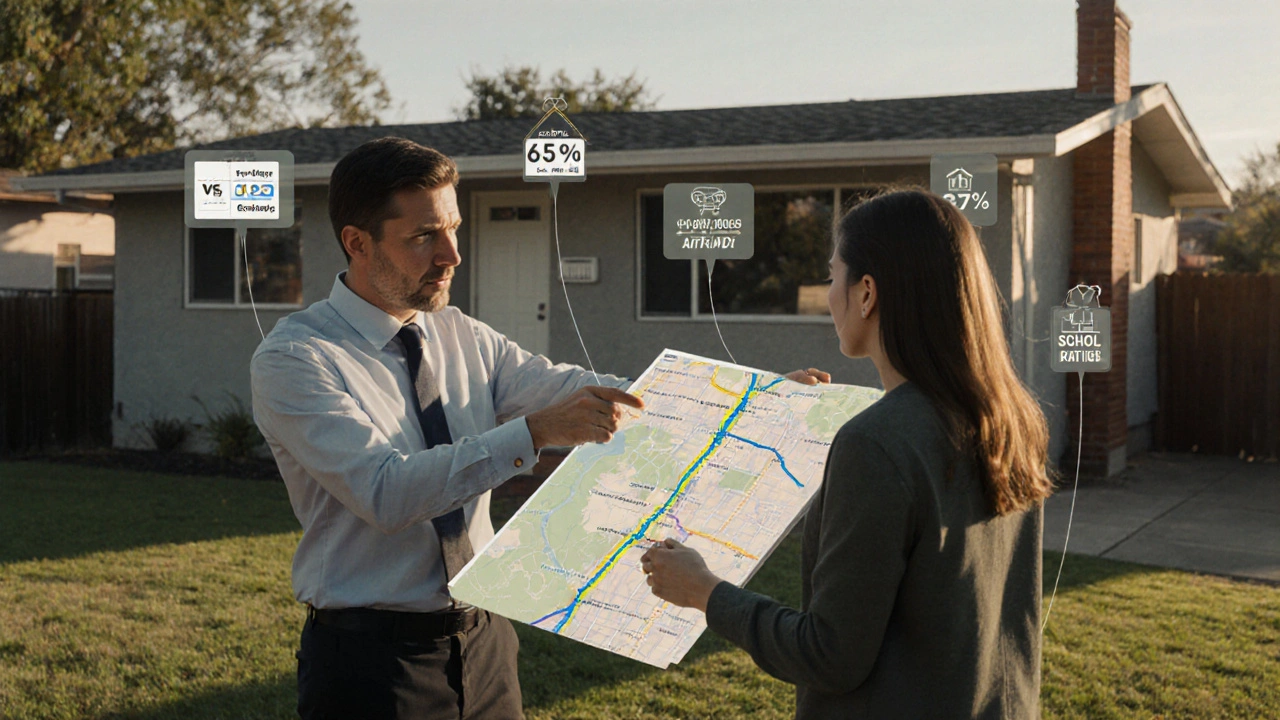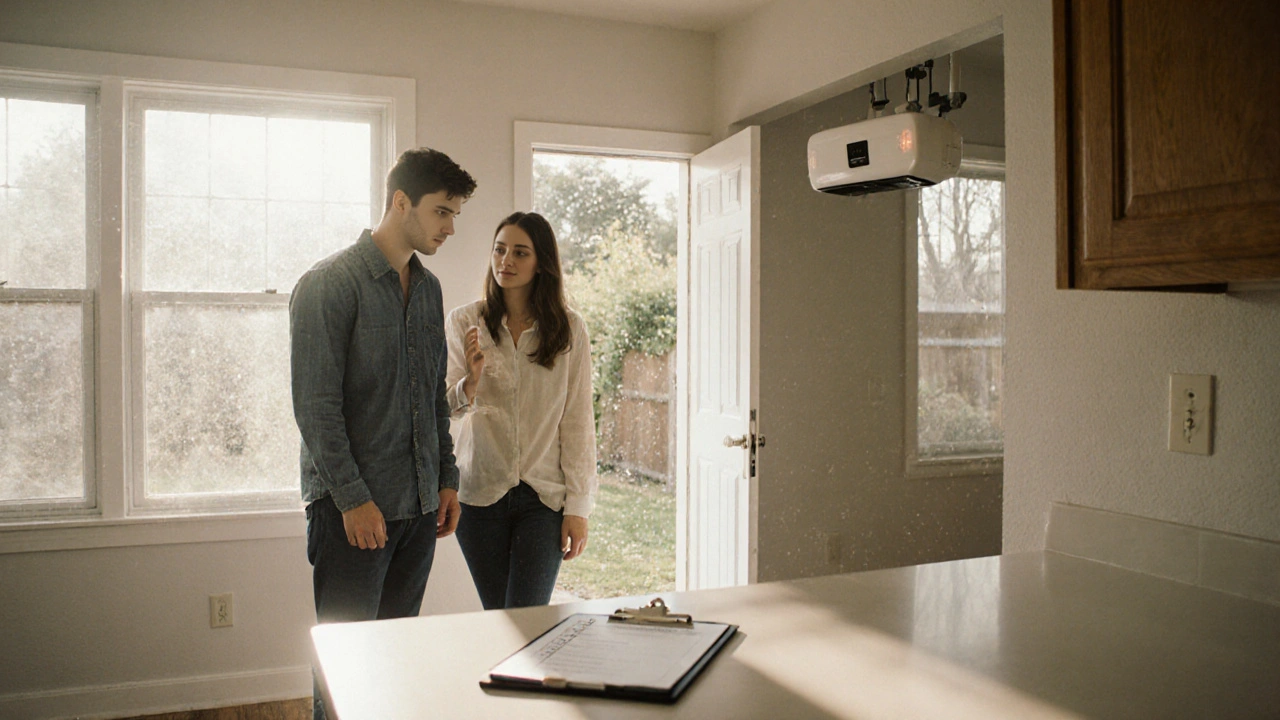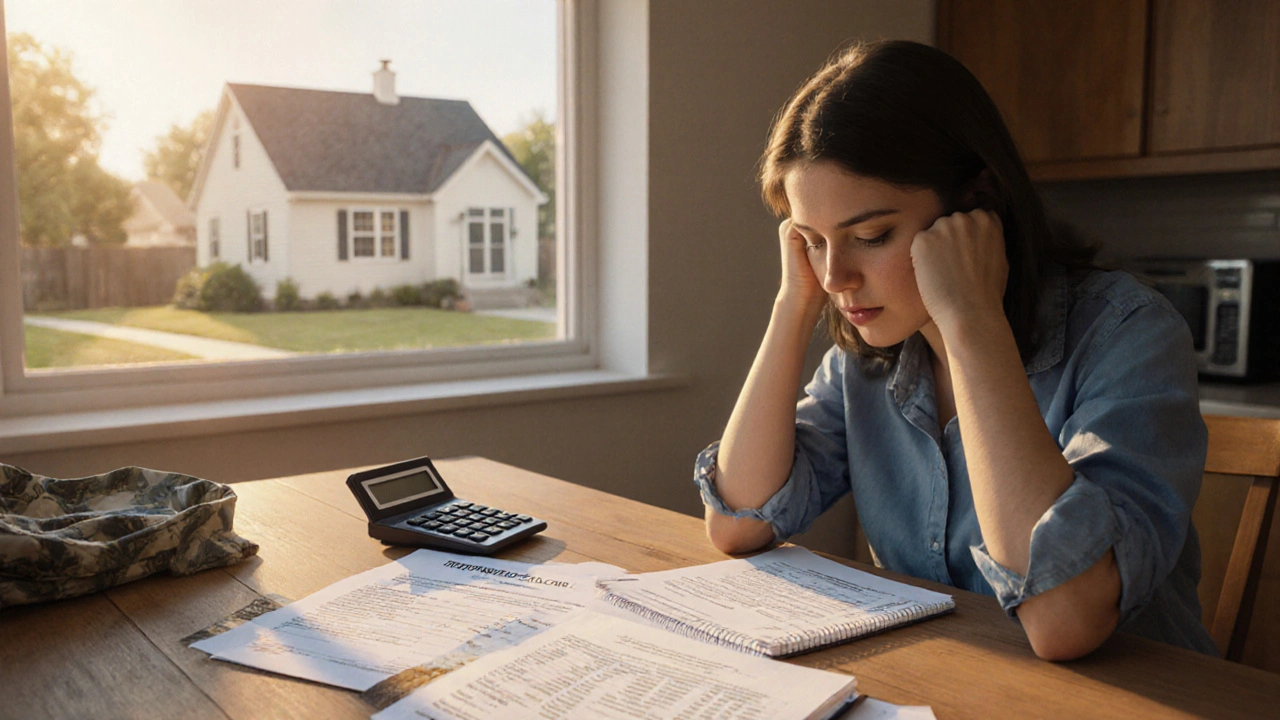Buying real estate isn’t just about finding a house. It’s about locking in your future-where you’ll sleep, raise kids, build equity, and maybe even retire. But if you’ve never done it before, the process can feel like navigating a maze blindfolded. Mortgage rates, inspection red flags, bidding wars, closing costs-each step adds pressure. And with the 2025 market still adjusting after years of wild swings, knowing what’s real versus what’s hype matters more than ever.
Start with your finances, not your dream home
Most people begin by scrolling through Zillow, falling in love with a farmhouse with a wraparound porch. Then they hit a wall: they can’t afford it. The truth? You need to know what you can actually borrow before you fall for a property.
Get pre-approved for a mortgage. Not pre-qualified-pre-approved. That means a lender has checked your credit, income, and debt and told you exactly how much they’ll lend. In 2025, average 30-year fixed rates hover around 6.2%, down from 7.8% in early 2024. That’s still high compared to 2020, but better than last year. A pre-approval letter also makes your offer stand out. Sellers don’t want to waste time on buyers who can’t close.
Don’t forget the extra costs. Closing costs run 2-5% of the home price. That’s $6,000-$15,000 on a $300,000 house. You’ll also need money for inspections, appraisals, moving, and maybe new appliances. Most experts recommend keeping at least 3-6 months of living expenses in savings after you buy. If you’re using all your cash for the down payment, you’re setting yourself up for stress.
Decide what kind of property you really need
Is it a starter home? An investment? A forever home? Each goal changes your strategy.
First-time buyers often think they need to buy the perfect house. But in markets like Boulder, Austin, or Nashville, that’s a trap. A fixer-upper in a good school district might cost $50,000 less than a move-in-ready home. And if you’re planning to live there five years or more, the upgrades you make can pay off big time.
Condos and townhomes are rising in popularity. They’re cheaper, easier to maintain, and often come with amenities like gyms or pools. But they also come with HOA fees-sometimes $500 a month or more. Read the rules. Some HOAs ban short-term rentals, pets, or even window air conditioners.
And don’t ignore the neighborhood. A $200,000 house in a safe, walkable area with good schools and public transit is a better long-term bet than a $300,000 house in a quiet cul-de-sac with no grocery store for miles. Check crime stats on SpotCrime. Look at Google Street View at different times of day. Talk to neighbors. Ask about noise, parking, and whether the city plans new roads or developments nearby.
Work with a buyer’s agent-don’t go it alone
You might think you can save money by dealing directly with the listing agent. Don’t. That agent works for the seller. Their job is to get the highest price and best terms for the person who hired them.
A buyer’s agent works for you. They know the market, spot hidden issues, and negotiate on your behalf. In most cases, the seller pays their commission, so it doesn’t cost you extra. A good agent will help you find off-market listings, understand appraisal gaps, and avoid bidding wars in hot neighborhoods.
Ask for referrals from friends who bought recently. Look for agents with at least five years of experience in the exact area you’re targeting. Check their reviews on Google and Zillow. Ask them how many offers they’ve helped clients win in the last six months. If they say “a lot,” ask for numbers. A top agent in a competitive market might close 20-30 deals a year.

Make an offer that wins-without overpaying
In 2025, many markets are still competitive, especially in the $300,000-$600,000 range. But it’s not like 2021, when people were offering $100,000 over asking. Sellers are more realistic now.
Your offer should be based on recent comparable sales-“comps.” Your agent will pull these. Look for homes sold in the last 90 days that are similar in size, age, and condition. If the house you want sold for $420,000 last month, and the one across the street sold for $415,000, don’t offer $450,000.
Contingencies are your safety net. Always include:
- A home inspection contingency-you can walk away if major issues are found
- A financing contingency-you’re not locked in if your loan falls through
- An appraisal contingency-the house must appraise for at least your offer amount
Some buyers skip these to seem “stronger.” That’s risky. A $5,000 repair you didn’t know about can cost you $15,000 in hidden debt later.
If the market is tight, you can add a personal letter to the seller-explain why you love the house. But don’t overdo it. Keep it short. Avoid mentioning kids, religion, or politics. Focus on the home: “We love the natural light and the backyard for gardening.”
Close with your eyes open
The closing day isn’t the finish line-it’s the final checkpoint. You’ll sign a stack of papers. Some are legal. Some are just forms. Don’t rush.
Review the Closing Disclosure at least three days before closing. It shows your final loan terms, fees, and how much you owe. Compare it to your Loan Estimate from when you applied. If something changed-like a higher interest rate or new fee-ask why. Lenders can’t change terms without your approval.
Do a final walkthrough 24 hours before closing. Check that the sellers left the house clean. Make sure appliances work. Confirm the garage door opener is still there. Look for new damage. If the sink is broken or the fridge is gone, you can ask for repairs or a credit at closing.
Bring a certified check or wire the funds as instructed. Don’t show up with cash. And don’t open any new credit cards or take out a car loan right before closing. Even a small change in your debt-to-income ratio can delay or kill your loan.

What most first-time buyers miss
Here are the three things no one tells you:
- You’ll pay property taxes every year. In Colorado, they’re around 0.5% of home value. On a $400,000 house, that’s $2,000 a year-paid in two installments.
- Homeowners insurance isn’t optional. It costs $1,200-$2,500 a year, depending on your area and home type.
- Maintenance isn’t a one-time thing. Roofs last 20-30 years. HVAC systems need servicing every year. Water heaters fail without warning. Budget $3,000-$5,000 a year for repairs.
Many buyers think they’re done after closing. But the real work starts now. Keep receipts for upgrades. Take photos of everything when you move in. That’ll help if you ever sell.
Is now the right time to buy?
There’s no perfect time. If you’re ready to settle down, have steady income, and can afford the long-term costs, then yes. If you’re waiting for rates to drop to 3%, you might wait forever.
Real estate isn’t a get-rich-quick scheme. It’s a slow, steady way to build wealth. In the last 20 years, U.S. home prices have grown about 4% a year on average. That’s not flashy, but it beats inflation and savings accounts.
Buy because you want to live there-not because you think it’s an investment. The best homes are the ones you love to come home to.
How much down payment do I need to buy a house in 2025?
You can buy a home with as little as 3% down through FHA or conventional loans. But putting down 20% avoids private mortgage insurance (PMI), which can add $100-$200 a month to your payment. First-time buyers often use FHA loans, which require 3.5% down and allow lower credit scores. If you’re a veteran, VA loans offer $0 down. USDA loans also offer zero down in eligible rural areas.
Can I buy a house with bad credit?
Yes, but it’s harder and more expensive. FHA loans accept credit scores as low as 580 for 3.5% down. If your score is below 580, you’ll need 10% down. Rates for scores under 620 can be 1-2% higher than for scores above 740. That means paying thousands more in interest over 30 years. Start by paying down debt, disputing errors on your credit report, and making all payments on time for at least six months before applying.
What’s the difference between a home inspection and an appraisal?
An inspection checks the condition of the house-roof, wiring, plumbing, mold, pests. It’s for your protection. An appraisal estimates the home’s market value so the lender knows they’re not lending more than the house is worth. The buyer pays for the inspection. The lender pays for the appraisal. You can walk away after a bad inspection. You can’t walk away just because the appraisal is low-you’d need to renegotiate the price or bring more cash.
Should I buy a new build or an older home?
New builds come with warranties, modern energy efficiency, and no surprise repairs. But they’re often more expensive per square foot and lack character. Older homes have charm, larger lots, and better locations-but may need roof, plumbing, or electrical updates. In 2025, new construction is growing, especially in suburbs. But inventory of move-in-ready older homes is still tight in many cities. Choose based on your budget and tolerance for work.
How long does it take to buy a house?
On average, it takes 40-50 days from offer to closing. The timeline depends on your loan type, how fast you get inspections done, and how busy the title company is. FHA loans can take longer because of extra paperwork. Cash buyers can close in under two weeks. If you’re in a hurry, make sure your lender is experienced with fast closings and you’ve got your documents ready before you start looking.

15 Responses
Just bought my first place last month. Pre-approval was the only thing that kept me from crying over Zillow listings. 6.2% hurts but at least it’s not 7.8%. Skip the drama. Do the math.
LOL you think 6.2% is bad? Wait till the Fed drops a surprise rate hike next quarter. They’re just lulling you into false security. The banks are playing 4D chess and you’re still buying into the ‘starter home’ fairy tale. You’ll be paying PMI till 2040 and wondering why your ‘investment’ is a money pit.
Real estate isn’t wealth building. It’s just inflation with extra steps. You’re not ‘locking in your future’-you’re locking in a mortgage payment while your renter neighbors in Austin are flipping NFTs. Congrats, you’re now the landlord of your own emotional baggage.
It’s mildly concerning that this guide still refers to ‘first-time buyers’ as if they’re a monolithic demographic. The reality is that 72% of first-time purchasers in urban centers are now non-traditional households-cohabitating partners, single parents, or multigenerational units. The language of ‘starter home’ is archaic and economically exclusionary. Consider revising for intersectional financial literacy.
My cousin just bought in Ohio. Said the agent was a lifesaver. Didn’t even know about HOA rules until she got the packet. Now she’s stuck with no pets and no AC. Read the fine print. Always.
Just… breathe. You don’t need the perfect house. You need a roof that doesn’t leak and a door that locks. I bought a 1978 ranch with termites and a weird kitchen. Now I’ve got a garden and peace. Stop scrolling. Start living.
YES. The closing disclosure review is SO underemphasized. I missed a $1,200 fee because I trusted the lender. Don’t be me. Read every line. You’re not signing a contract-you’re signing your life for 30 years.
bro just get pre approved and stop overthinking it. i got my house with 3.5% down and zero regrets. the inspection found a leaky faucet and a broken porch light. fixed it for $80. you’re not buying a museum. you’re buying a place to sleep. chill
They’re hiding the truth. The government is pushing this to get you locked into debt so you can’t protest. You think you’re buying a house? You’re buying a surveillance tool. Every smart appliance feeds data to the bank. Your HVAC usage, your water consumption, your doorbell camera-ALL tracked. Wake up.
I’ve been through this. Twice. First time, I trusted the agent. Second time, I cried in the bathroom after the appraisal came in $40k under offer. I lost my deposit. My girlfriend left me. I moved back in with my mom. I’m 34. I still have nightmares about the smell of new carpet and the sound of a closing bell. Don’t do this unless you’re ready to lose everything. And even then… maybe don’t.
Who told you FHA loans are safe? They’re a trap. The government uses them to push minorities into overpriced neighborhoods so they can displace them later. You think you’re building equity? You’re building a gentrification target. Read the redlining maps from 1950. They’re still alive in today’s appraisals.
Just wanted to say THANK YOU for mentioning HOA rules 😭 I didn’t know my condo banned bird feeders. Now my balcony is empty but my peace of mind? Priceless. 🙏🌿
While the article appropriately highlights the necessity of contingencies, it fails to address the emerging legal landscape surrounding AI-driven property valuations and algorithmic bias in underwriting, which disproportionately affects marginalized communities. The reliance on comparable sales, while pragmatic, perpetuates historical inequities embedded in housing data. A truly comprehensive guide must interrogate the epistemological foundations of market comparables-not merely their numerical outputs.
Pre-approval > pre-qualified. Always. And never skip the walkthrough. I once bought a house where the seller took the light fixtures. Literally. Every single one. Even the bathroom towel rack.
You think you’re buying a house. But you’re really buying into a system designed to extract wealth from the working class. The 4% annual appreciation? That’s not growth. That’s inflation disguised as equity. The real winners are the banks, the agents, the insurers, and the developers. You’re just the renter with a mortgage.